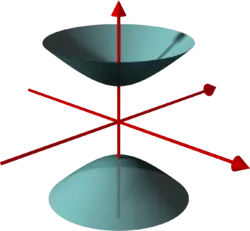Hamilton’s real quaternions H and biquaternions B are constructed from pairs of division binarions or complex binarions, respectively. These operations are defined:
A third quaternion algebra Q = split quaternions is a variant of H and a subalgebra of B; it has other derivations.
H and B were both described by W. R. Hamilton in his Lectures on Quaternions (1853). AC algebra Q was described by James Cockle and called coquaternions. For a time H, B, and Q had special profiles in their use as AC algebra, but matrix rings were exploited in the twentieth century to provide linear representations for them, and thus absorb them into the larger study of linear algebra. Indeed, Q is ring isomorphic to M(2,R), the 2 × 2 real matrices, and B is ring isomorphic to M(2,C), the 2 x 2 complex matrices. Representation of H uses the context in B. In the context of general Linear Algebra the idea of composition is visible with the determinant of a matrix which has a similar property.
Division quaternions
In the notation of Hamilton, with (w,z) is written a + bi + cj + dk, where the products can be confirmed, and noted for anticommutativity. The set {i, j, k} has been taken as the basis of space in presentations of kinematics, mechanics, and physical science. The anticommutative products illustrate cross products.
Furthermore, In fact,
- so there is a sphere S2 of imaginary units in H.
Say that u is one of them, then the complex arithmetic of Euler's formula gives In the quaternion context, eau is a versor, and versors are the points of elliptic space, a geometry entirely devoted to rotations. W. K. Clifford was an exponent of elliptic geometry, and much more, until his flame was extinguished at age 34.
For vectors in V ⊂ H, anticommutivity means perpendicularity:
Lemma: if a and b are square roots of minus one and a ⊥ b, then aba = b.
- proof:
Lemma: Under the same hypothesis, a ⊥ ab and b ⊥ ab.
- proof:
Let u = exp(θ r) be a versor. There is a group action on H determined by u:
Note that u commutes with all elements in the plane Select s from the great circle on S2 that is perpendicular to r. Then rsr = s by the first lemma. Now compute f(s):
- which is rotation by 2 theta in the (s, sr) plane.
This feature of H, inner automorphism f producing rotation, has proven very useful.
Biquaternions
The AC algebra (B, +, x, * ) has conjugation
In biquaternions a new imaginary unit h commutes with all the other imaginary units i, j, k, r, r2 = - 1. For example, w = a + b h, a,b in R, w a division binarion.
Suppose now the complex conjugation is invoked:
Define
Then
This four-dimensional subspace was exploited by Ludwik Silberstein (1914) and Cornelius Lanczos (1949) to exhibit a mathematical model of spacetime with speed of light set to one, and admitting Lorentz transformations as conjugation of an event by a versor or hyperbolic versor.
In B, for each square root of -1, r ∈ S2, (hr)2 = +1. Then the plane
- is a split binarion algebra with (x + y(hr))* = x - y(hr). In particular
- with hyperbolic angle a, is a hyperbola in the plane of R and hr.
Hyperbolic rotation, or squeeze, can be obtained by conjugation with u. Using r and s ∈ S2 ⊂ H as above, then
- which is hyperbolic rotation of s by a hyperbolic angle 2a in the (s, hsr) plane.
The real vector s, outside of M, is found to have a component (sinh a) hsr ∈ M after f.
Exercises
1. Let f be a mapping on B given by f(s) = v s v, where v = exp(a hr). Show that r ⊥ s implies f(s) = s.
2. Show f(eb hr) = exp((2a + b) hr).
3. Interpret f as a mapping on M. Hint: Use terminology of special relativity.
Split quaternions

There are at least three portals leading to split quaternions: the dihedral group of a square, matrix products in M(2,R), and the modified Cayley-Dickson construction. The work of Max Zorn on split octonions showed the necessity of including split real AC algebras in the aufbau of the category.
The development through the dihedral group was started with a lemma in the Introduction, and is completed with exercises below.
Or one can start with a basis {1, i, j, k} taken from M(2,R), where the identity matrix is one, is j, is i, and is k. Some practice with matrix multiplication shows they are anticommutative like division quaternions, but some products differ:
- j2 = +1 = k2, j k = − i .
Then the real AC algebra of split-quaternions uses coefficients w, x, y, z ∈ R to express an element, its conjugate, and the quadratic form N:
Exercises
1. What are the involutions on a square ?
2. As reflections, what is the angle of incidence of the axes of reflection ?
3. The composition of these reflections has what angle of rotation ?